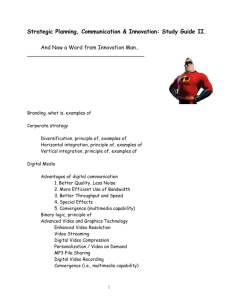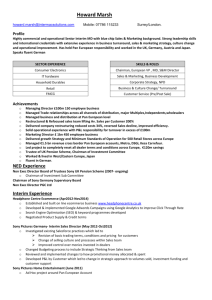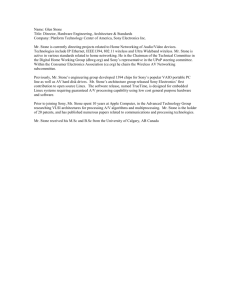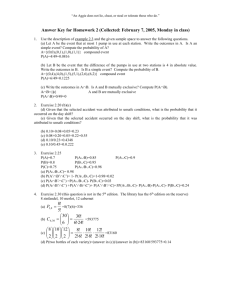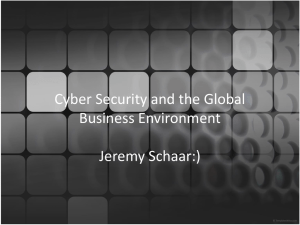Case Study: How an Interactive Game Stimulated Product
advertisement
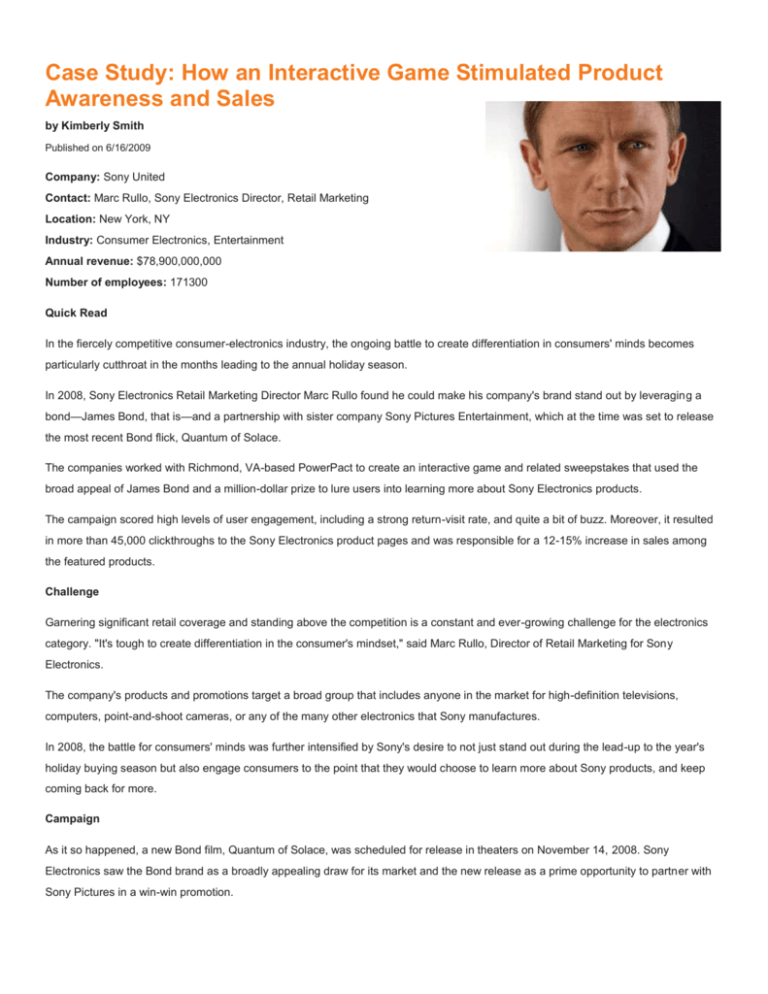
Case Study: How an Interactive Game Stimulated Product Awareness and Sales by Kimberly Smith Published on 6/16/2009 Company: Sony United Contact: Marc Rullo, Sony Electronics Director, Retail Marketing Location: New York, NY Industry: Consumer Electronics, Entertainment Annual revenue: $78,900,000,000 Number of employees: 171300 Quick Read In the fiercely competitive consumer-electronics industry, the ongoing battle to create differentiation in consumers' minds becomes particularly cutthroat in the months leading to the annual holiday season. In 2008, Sony Electronics Retail Marketing Director Marc Rullo found he could make his company's brand stand out by leveraging a bond—James Bond, that is—and a partnership with sister company Sony Pictures Entertainment, which at the time was set to release the most recent Bond flick, Quantum of Solace. The companies worked with Richmond, VA-based PowerPact to create an interactive game and related sweepstakes that used the broad appeal of James Bond and a million-dollar prize to lure users into learning more about Sony Electronics products. The campaign scored high levels of user engagement, including a strong return-visit rate, and quite a bit of buzz. Moreover, it resulted in more than 45,000 clickthroughs to the Sony Electronics product pages and was responsible for a 12-15% increase in sales among the featured products. Challenge Garnering significant retail coverage and standing above the competition is a constant and ever-growing challenge for the electronics category. "It's tough to create differentiation in the consumer's mindset," said Marc Rullo, Director of Retail Marketing for Sony Electronics. The company's products and promotions target a broad group that includes anyone in the market for high-definition televisions, computers, point-and-shoot cameras, or any of the many other electronics that Sony manufactures. In 2008, the battle for consumers' minds was further intensified by Sony's desire to not just stand out during the lead-up to the year's holiday buying season but also engage consumers to the point that they would choose to learn more about Sony products, and keep coming back for more. Campaign As it so happened, a new Bond film, Quantum of Solace, was scheduled for release in theaters on November 14, 2008. Sony Electronics saw the Bond brand as a broadly appealing draw for its market and the new release as a prime opportunity to partner with Sony Pictures in a win-win promotion. "Bond is a huge franchise well known by all factions of consumers," said Rullo. "Bond represents 'cool,' sophistication, and the use of sophisticated technology. We took advantage of that opportunity to have a conversation with consumers about that and pay it back to our own devices." Together with promotion and shopper-marketing agency PowerPact, the Sony businesses created an integrated campaign around a Bond-themed game and related sweepstakes contest, which launched on September 29, 2008 and ran for eight weeks. The game largely took place on a Sony microsite (removed after the promotion period), where visitors registered as "agents" and pursued a series of spy missions—each of which involved using virtual Sony Electronics products to retrieve "stolen" Sony HDNA (a tiein to an ongoing marketing campaign Sony launched in 2007 to establish the notion that high-definition is a central part of the company's DNA). New missions were released on a weekly basis, and users were able to opt in for email, phone, or text alerts announcing each release. Every week, before users could proceed through the next mission, however, they were prompted to watch behind-the-scenes Quantum of Solace clips and answer trivia questions related to both the movie itself and the gadgets used to examine the clips (i.e., Sony Electronics products). For each trivia question correctly answered and every mission successfully completed, the user would then gain another entry into the sweepstakes, which boasted a million-dollar grand prize and a trip to a secret location (a private prescreening of the film, when, with the film's stars present, the agents would receive their prizes). Instant-win opportunities were also made available via additional trivia questions, which helped to further educate users about the film and Sony products, while increasing engagement and "stickiness" on the microsite. A downloadable widget and wallpapers available on the microsite encouraged additional engagement and sharing. The widget was, in fact, picked up by more 300,000 bloggers, media outlets, and individual users. Among other promotions used to drive consumers to the microsite were the following: Friend referrals, which enabled users to earn bonus sweepstakes entries by recruiting their friends using an invitation feature on the microsite Email sent out to Sony's customer database to build awareness for the game and alert users of new mission releases Banner ads placed on technology and gamer sites, social networks, and retail-partner sites A James Bond AOL bot to interact with IM users Facebook promotions, including an interactive application, information, and links to the microsite, and special perks such as a downloadable limited-edition 007 logo Retailer support using Bond-themed window and POS displays Theater promotions in connection with the upcoming Quantum of Solace release PR support from the various blogs and media outlets that picked up the story Results In all, Sony estimates, the promotion received more than 496,000 gross media impressions. Each mission received in the range of 10,000 to 50,000 plays, with a large percentage of agents completing between five and seven missions apiece. In addition, more than 86,000 individual trivia sessions were played, with over 3.9 million trivia questions answered in all, demonstrating that agents were engaged in and returning to the feature to answer additional questions. On average, users spent over four minutes on the microsite per visit, which was double the length of time Sony was shooting for. Users also showed interest in the products they interacted with on the site, accounting for more than 45,000 clickthroughs to the Sony Electronics product landing pages and a 12-15% increase in sales among those products. Lessons Learned Educate with entertainment: Sony was able to get users engaged with its products and demonstrate product strengths by incorporating those products directly into the game and compelling users to interact with them via a fun and rewarding experience. Plus, by aligning sweepstakes entries with product trivia, users chose to continue that engagement process, leading to longer visits on the microsite and strong clickthrough rates to the Sony product pages. Get the whole gang involved: Cooperation among multiple Sony business units and the company's retailers resulted in both promotional synergy and a more robust user experience. By piggybacking on each other's promotions and the appeal of James Bond, all properties garnered broader awareness; for example, while retailer window and POS displays helped promote the game and build excitement for the film, retailers also benefited from boosted interest in Sony products, increased advertising for Bond DVDs and video games—and more foot traffic, as one of the missions in particular drove agents to the retail shops in order to retrieve a special code needed to solve that mission. Overall, users were exposed to brand elements and product information in multiple channels, online and offline, which further boosted the likelihood of exposure and engagement while helping to make the game more interesting for users. Strive for ongoing engagement: Sony achieved a high completion rate for the game, with many users solving five or more missions. The email, phone, and text alerts, for which over 17,000 agents opted in, were an especially effective mechanism for reminding users to return. Still, the campaign did experience some drop-off after a strong launch; Rullo said ongoing engagement and overall results may have been further boosted by (a) allowing access to all of the missions at the same time so that users could continue at their own pace; (b) including additional offers and activations on the microsite; (c) extending the media buys, which were concentrated toward the beginning of the promotion; and (d) limiting the campaign to four weeks. What's your "special agent" for boosting customer engagement? Email your story to CaseStudies@MarketingProfs.com.
